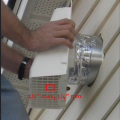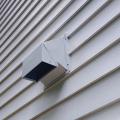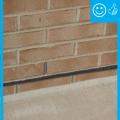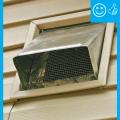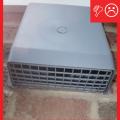Scope
Design the home and install deterrents to discourage birds, rodents, and other pests from perching or nesting in or around openings in homes.
- Design simple roofs and use metal step and valley flashing and leaf guards over gutters to discourage the build up of nesting materials and/or rotting of roofing materials that could provide harborage or entry for animals.
- Design the home with sloped rather than horizontal ledges, columns headings, fixtures, etc., to discourage nesting and perching.
- Install corrosion-proof wire mesh screening with ¼ inch or smaller holes over all vent openings unless the vent provides air to an air handler.
- Use sturdy soffit vent covers that are mechanically attached to framing to resist displacement by high winds and animals.
- Install a stainless steel chimney cap with screening to keep out birds, animals, snow, and rain and to keep in fireplace embers.
See the Compliance Tab for links to related codes and standards and voluntary federal energy-efficiency program requirements.
Description
Birds, rodents, bats, and insects can carry bacteria, viruses, parasites, fungi, and allergens that can cause illnesses to home dwellers. If they get into homes, attics, basements, or ducts, they can also cause considerable property damage (Figure 1). If they get into a home’s HVAC system, allergens and contaminants can quickly be dispersed throughout the home.

Pests can enter through surprisingly small openings (Figure 2).

Gaps as small as 1/4 inch (the width of a pencil) are enough for mice to squeeze through into the wall cavity or interior of the house. All vents and duct openings for heating and air conditioning should be covered with durable metal screens to prevent animal entry. A wide range of animals, from sparrows to raccoons, can find their way into a building through the ventilation openings located in the soffits under the eaves. Crawlspace vents are another common entry point for animals. A bonus of installing screens and filters is that these materials may also block the entry of embers originating from fires.
Caution: Hardware cloth less than 1/2 x 1/2 inch (1.3 x 1.3 cm) significantly reduces air flow. In some locations, small-mesh screens can become clogged with dust or freeze over. Hardware cloth covering air handler intake vents should not be less than 1/2 x 1/2 inch (1.3 x 1.3 cm), unless the covering is recommended by the manufacturer. Instruct the homeowner to periodically clean the screen.
Materials and Installation
Screening used to prevent pest entry should be made of a durable moisture-resistant, gnaw-resistant material. The following recommendations are from Best Practices for Nuisance Wildlife Control: A Training Manual, prepared by the Cooperative Extension Service.
- Galvanized sheet metal is durable and, when attached with screws, resistant to removal by raccoons and other animals, but it can be hard to bend and fit around corners.
- Galvanized hardware cloth (or "metal mesh") is easier to shape than sheet metal and is reasonably durable (Figure 3). Hardware cloth is generally available in quarter-inch and half-inch mesh sizes. Half-inch hardware cloth is stronger but less flexible than quarter-inch. To keep smaller animals, such as bats or mice, out of an area, use quarter-inch hardware cloth.
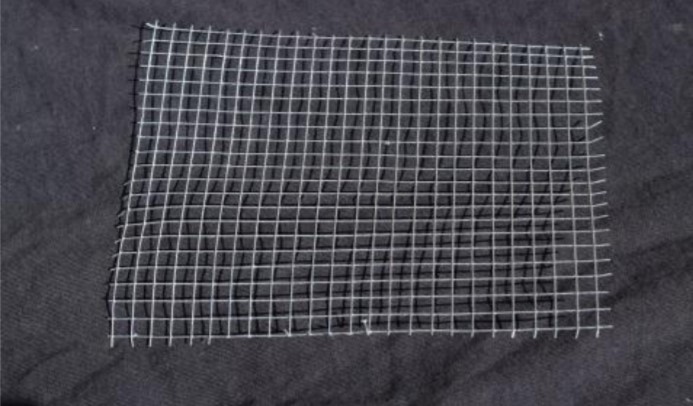
- Stainless steel or vinyl-coated hardware cloth is stronger than galvanized and will never rust. The disadvantages of stainless steel are that it is much more expensive and harder to cut and shape.
- Vinyl-coated, welded wire mesh is even stronger than hardware cloth. It lasts longer and will never rust (one manufacturer guarantees its product for seven years when used in the ocean), but it is more expensive than hardware cloth. Welded wire mesh is sold in rolls and is available in different heights, gauges, and mesh sizes. Some nuisance wildlife control operators prefer to use welded wire mesh to create rat walls and for any other installation that is meant to last a long time. The recommended size to keep out larger animals is 1×1-inch mesh, while ½×½-inch mesh is suitable for most smaller animals, except mice, which require 1/4×1/4-inch mesh.
- Other materials used as shields, guards or barricades to discourage pests include concrete, brick, and aluminum and galvanized sheet metal (See Table 1).
Table 1. Rodent-Resistant Construction and Exclusion Materials (Source: Geiger and Cox 2012).
| Material | Uses | Thickness |
|---|---|---|
| Concrete | Slabs, curtain walls, foundation walls, ground cover barriers | ≥ 2 inches (5.1 cm) if reinforced, or 3.75 inches (9.5 cm) if not reinforced |
| Brick | Curtain walls, facades to ground-level | 3.75 inches (9.5 cm) thick with joints filled with mortar |
| Galvanized sheet metal | Wall or pipe barriers | 24 gauge or heavier |
| Kick plates or door edging | 22-gauge or heavier | |
| Perforated or expanded sheet metal grills | 14-gauge | |
| Hardware cloth | Wire mesh to exclude rats | if woven, 19-gauge, 1/2 x 1/2-inch (1.3x1.3-cm) mesh |
| Mesh to exclude mice | 24-gauge, 1/4x1/4-inch (0.6x0.6-cm) | |
| Aluminum | Frames and flashing | 22-gauge |
| Kick plates and guards. | 18-gauge |
Design and Installation Tips to Discourage Roosting and Nesting by Birds and Other Animals
- Design roofs that are simple; avoid gables, dormers, and roof-wall junctures that can form nesting and hiding spots for birds and other animals.
- Install metal step flashing at all roof-wall junctures and in roof valleys to reduce the likelihood of vegetative debris collecting where it can create nesting spots. Metal valley flashing installed over peel-and-stick membranes also protects roofing materials from rotting and creating weak spots where animals can enter the attic.
- Choose designs for exterior structures like decorative screens, moldings and lattices, siding, awnings, window sills, signs, fire sprinkler pipes, and column capitals with sloped tops that minimize opportunities for bird perching, roosting, or nesting, especially near building entrances. Use smooth materials and avoid horizontal surfaces. Slope window ledges and projections at 45 degrees to minimize bird perching and roosting.
- Choose light fixtures with sloping surfaces rather than horizontal surfaces to deter bird roosting and nesting.
- Cover attic and crawlspace ventilation openings and windows with woven or welded galvanized hardware cloth, screen, or filters to prevent entry by rodents, birds, and bats. For large openings or where the screen may be subject to abuse, add crossbars to support the hardware cloth. If the opening must be accessible, install the screen on a hinged frame.
- Use sturdy soffit vent covers that are mechanically attached to framing or blocking every 12 inches to resist displacement by high winds and animals. If the vent openings are larger, install hardware cloth behind them or replace with narrow metal louvered grates.
- To minimize the entry of flying insects, install screens on all operable windows and passive ventilation openings and install filters on all HVAC air intake ports.
- Install bird stop in the open ends of rounded roof tiles.
- Install leaf guards on gutters to minimize collection of leaves, branches, and other nesting materials.
- Screen in openings in buildings, exposed rafters in porch roofs, and other likely perches in semi-enclosed areas with rust-proof ¾-inch wire or plastic mesh to exclude birds or ½-inch metal mesh to exclude rodents.
- Install bird spikes, "porcupine wire," netting, or similar devices to discourage birds from nesting on light fixtures or use bird exclusion devices, including wires, springs, nets, and electrical strips, to prevent birds from reaching light fixtures and other perching spots. (Note these devices are not foolproof and do require maintenance.)
- Cover clothes dryer exhaust duct openings with opening gravity louvers. Do not install screens over dryer exhaust duct terminals.
- Mouse-proof interior residential air return grilles by placing 1/4-inch (0.6-cm) hardware cloth behind the grille.
See the guide Reduce Pest Intrusion for more detailed information and a more far-reaching discussion of avoiding pests.
Success
Inspect to verify that screening materials are present in all vents and openings, that screens are made out of rust-resistant durable materials, and that screening is securely mechanically fastened in place to prevent removal by pests.
Climate
Pests
Rodents, birds, various insects, and other pests are present throughout the United States.
Termites are prevalent in the central and southern United States (see termite infestation map). Corrosion-resistant stainless steel termite shields should be installed at the top of foundation walls beneath the sill plate to discourage termite entry.
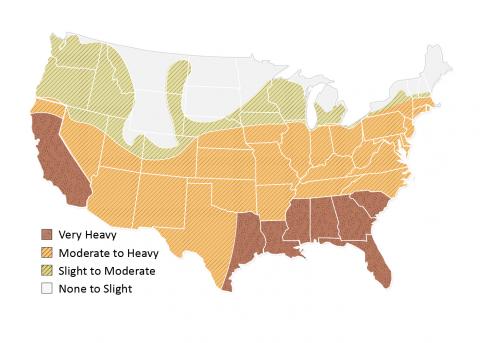
Training
Compliance
Retrofit
SCOPE
Inspect all building openings in the existing home that can’t be sealed (ventilation system intakes and exhaust outlets, attic vent openings, etc.)
If any openings are found to be lacking corrosion-proof wire mesh screening with ¼-inch or smaller holes, install screening as described in the Description tab.
See the U.S. Department of Energy’s Standard Work Specifications for more on preventing pest entry and infestation.
DESCRIPTION
Protect vent openings from bird and pest entry with durable, securely fastened screening as described in the Description tab.
If birds, bats, rodents, or other pests are already present in the vent openings or attic, consult a nuisance wildlife control operator for the appropriate removal procedures.
More
More Info.
Access to some references may require purchase from the publisher. While we continually update our database, links may have changed since posting. Please contact our webmaster if you find broken links.
The following authors and organizations contributed to the content in this Guide.

